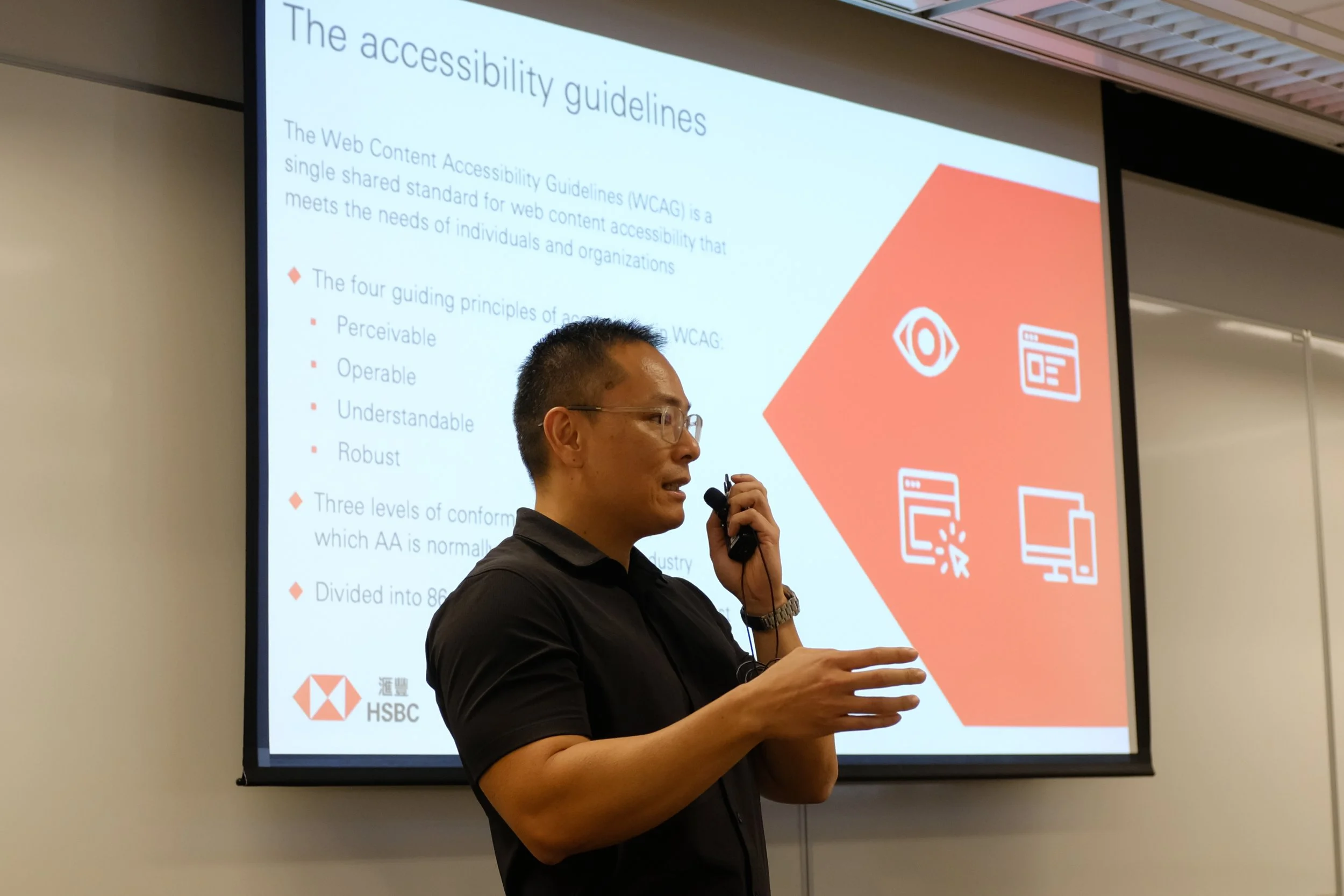Speaker Session: Robert Hsu & Bryan Nguyen — Accessibility in Design
In this speaker session, we are thrilled to welcome Mr. Robert Hsu and Mr. Bryan Nguyen from HSBC. They will shed light on the critical importance of accessibility in product design. With over 18 years of experience at HSBC, Robert currently serves as the Senior Manager of Digital Experience and Accessibility, having previously worked in various roles within Digital Design. Bryan, the Manager of Digital Accessibility, brings a wealth of knowledge in digital design to the table.
Bryan Nguyen talking to students about digital accessibility
The Importance of Accessibility in Design
In today's world, accessibility in design is not just a trend—it's a necessity. As we aim for inclusivity, creating products and spaces that cater to diverse needs is essential. Robert and Bryan illustrate this principle with the example of TooshLights, bathroom stall indicator lights at LAX. While the lights effectively signal occupancy status by turning red and green, they fall short for individuals with color vision deficiencies, which affect approximately 8% of the global population. This highlights the need for accessibility to be considered at every stage of the design process.
What Does Accessible Design Mean?
According to Robert and Bryan, accessible design equates to universal design, benefiting everyone regardless of disabilities or limitations. They emphasize four key principles for creating inclusive experiences:
(Make this into a graph)
Perceivable: Information should be accessible through multiple senses. For instance, individuals who are blind can receive information through sound.
Operable: Products must be easy to use, regardless of users' physical abilities.
Understandable: Clarity and simplicity are crucial, ensuring users can easily comprehend how to use the product.
Robust: Products should function well across various settings, such as ensuring browser compatibility and providing closed captions for videos.
Disabilities can be categorized into auditory, visual, physical impairments, and neurodiversity. Designing for a wide range of disabilities can be challenging, especially if designers lack awareness of the experiences of those with disabilities. Fortunately, international guidelines like the Web Content Accessibility Guidelines (WCAG) provide a framework for digital accessibility. However, merely adhering to these guidelines is not enough; Robert and Bryan stress the importance of user testing, creating a continuous feedback loop for ongoing improvements in accessibility.
The Challenges of Inclusive Design
The journey toward inclusive design is not easy; it challenges teams to dismantle potential barriers at every step. Empathy lies at the heart of this process, similar to the design thinking framework. Inclusive design requires the consideration of diverse personas with varying limitations, allowing developers and designers to understand how people with disabilities interact with products. This process involves various roles—analysts, designers, copywriters, and more—ensuring a comprehensive approach.
Why Prioritize Accessibility?
With approximately 1.3 billion people, or 16% of the global population, experiencing some form of disability, businesses worldwide have a strong incentive to prioritize accessibility. Disabilities can be classified as:
Make this into a graph ?
Permanent: Long-term conditions such as neurodivergence, blindness, or amputation.
Temporary: Conditions expected to improve, like fractures or cataracts.
Situational: Temporary limitations arising from specific environments, such as social anxiety or noisy spaces.
Robert and Bryan highlight two main reasons for companies to embrace accessibility: Commercial Benefits and Regulatory Imperatives. By committing to inclusivity, firms can gain a competitive edge, enhance customer satisfaction, and attract a broader clientele. Furthermore, a positive reputation is at stake; accessible products garner praise, while inaccessible ones risk public backlash. With stringent accessibility regulations in many markets, especially in banking, adhering to these standards is not just ethical—it's essential.
HSBC's Commitment to Accessibility
HSBC is dedicated to becoming the most digitally accessible bank globally, for both customers and employees. Digital accessibility is a core policy, requiring every employee to adhere to established guidelines. To ensure compliance, HSBC has implemented strict processes for rolling out accessible digital products. For instance, the HSBC banking app is compatible with screen readers, enabling seamless access for visually impaired users and those with dexterity issues.
Internally, HSBC promotes equal opportunity by ensuring that technology used by employees is also accessible. Robert and Bryan share the story of their colleague Kenny, who is visually impaired and serves as an accessibility manager. They note the significant improvements in HSBC's accessibility practices over the years. Previously, mandatory training lacked accessibility features, requiring visually impaired employees to rely on managers for assistance. Now, HSBC has transitioned to fully digital training, allowing all employees to engage equitably.
Conclusion
Robert and Bryan’s talk emphasizes the importance of considering inclusivity and accessibility throughout the design process. As the aging population faces various disabilities and limitations, it is crucial that products targeting the "silver economy" prioritize accessibility. Moving forward, we must recognize that accessibility is not an afterthought but a fundamental aspect of thoughtful design. As we develop the products of tomorrow, the question remains: how can we ensure that no one is left behind?
For more content like this check out our other Speaker Sessions


